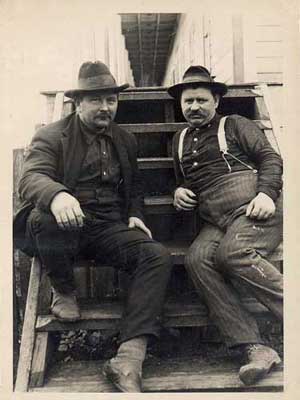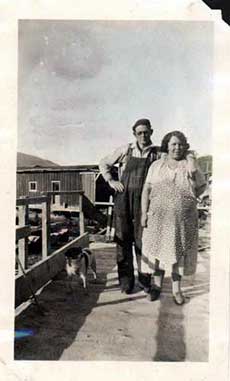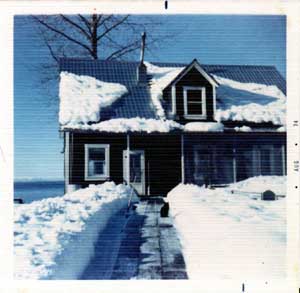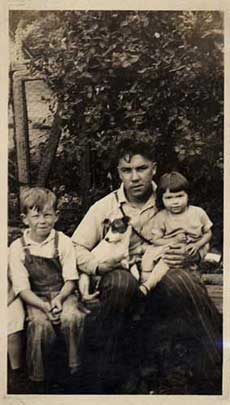 Its roots are deep in the region's past By June Allen September 26, 2003
Cannery fires were not uncommon in Alaska. In 1888 a fire destroyed the Tongass Packing Co. cannery in infant Ketchikan. Two years earlier a Capt. Berry had moved his packing plant from the Boca de Quadra area to Ketchikan, a promising little new settlement with a deep water harbor on the shipping lanes, a location with excellent possibilities for growth. The Berry cannery was located on the site later occupied by the legendary Stedman Hotel (and today by Downtown Drugstore). The cannery packed for two consecutive years before it burned. When the cannery was destroyed, Capt. Berry gave up and moved on, but his superintendent, George Clark, decided to stay. He threw in his lot with first resident Mike Martin and the partners began a salmon saltery operation diagonally across from the burned cannery site, about where the cruise ship dock's Front Street gazebo is now. The partners opened a trading post across the street. It may have been the location of Ketchikan's first post office, which opened in 1892 with George Clark as postmaster. Ketchikan had only 40 residents listed in the U.S. Census of 1890. But Loring, when Stack arrived there, was a good-sized town for 1890 Alaska - with a census count of 168 residents, a fair number of them year-round. Loring would remain the largest town on Revilla Island until the Gold Rush of '98 - a serious contender to become the future's largest city. The four-line Loring cannery was said to have been a sizeable plant for its time. Even after the burned portions of the cannery were repaired and operating, Richard Stack remained with the company at Loring, working at a variety of jobs over the years brailing traps for the cannery and other assigned duties. Early each summer the Alaska Packers Star Line's fleet of windjammers sailed north from California to the company's prosperous cannery operations scattered all along the coasts of Alaska. The deep-hulled, gracefully sleek and speedy wind-powered vessel that was headed for Loring was met by tugs on the outside waters of the west coast of Prince of Wales Island and towed to Loring. The ship brought in canning equipment, machinery, supplies for the year and the Chinese labor gangs, who immediately set up their quarters in "China houses" or camps along the shore behind the cannery buildings. The Chinese brought a pig or two
Then the sailors would hoist up the sails, take them down to store 'tween decks of the deep-hulled vessels and the bare-masted ship would stay tied up at Loring through the summer. At season's end the Chinese workers and the huge salmon pack of shiny cans would be loaded into the jam-packed hull and the ship would be towed to the outside waters to sail south again, the pack ready for market and the Chinese ready to send money home to their families in China. But not all the help at the cannery was Chinese. In the days before the Iron Chink and other labor-saving machines, canneries were very labor intensive. The Chinese had their own specific duties but there were many more steps in the canning process. A good number of the workers at Loring were Native Alaskans, mostly Tsimshian families that had been exposed to the value of the economic system from their spiritual leader, Father William Duncan. Among them was the Stewart family that had come to Alaska from British Columbia during the second wave of families moving north to Metlakatla. After a disagreement of some sort with Father Duncan, the Stewarts decided to leave Metlakatla. They traveled to Loring to work in the cannery. They were well settled when Richard Stack arrived in 1890. Loring was a busy place during the packing season. Temporary shacks were aired and provisioned and tents were pegged in the grasses and ground cover near the beaches. There was the ring of hammers and the rhythmic buzz of saws as year-round residents worked on permanent hillside homes. Children ran from place to place, played in the creek and darted into the bordering woods. Tsimshian families and friends from Metlakatla would often visit Loring to see acquaintances and relatives and there was much socializing. The permanent homes in Loring were (and are) connected by narrow boardwalks from house to house and to the beach and dock. Richard Stack early on staked out a homesite for himself and began work on his home after his workday was finished. It may have been along one of those boardwalks that he met and fell in love with Mariah Stewart. Father Duncan objected to his Tsimshian people marrying whites, but Mariah's family welcomed the match. The couple was married in 1894 in the house that still stands today in Loring, still a Stack family summer-home more than a hundred years later. Young Mrs. Mariah Stack had a number of friends in Loring, especially a Mrs. Collins who lived just up the way. When the Stack babies began to arrive, Mrs. Collins would be there to help at delivery. When Mrs. Collins delivered one of her ten children, Mariah Stack was there to help with the delivery and the older children. 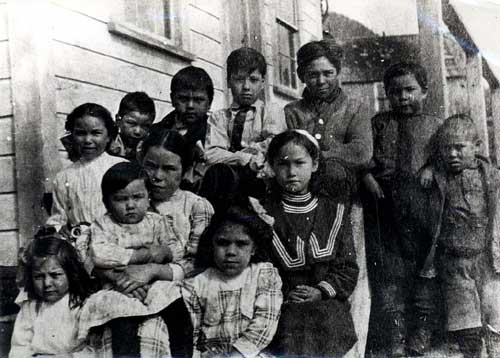 Photograph courtesy Lyle Stack
In spite of family tragedies, the Stacks were more fortunate than their friends, the Collins family. Collins lost his wife and nine of his ten children to tuberculosis in the 1920s, a period when TB was a deadly epidemic in Alaska. He moved to Wrangell and died there years later. Mr. Collins is remembered fondly by the Stack family to this day. It was Collins, interested in arboriculture, who brought Balm of Gilead trees to Loring from the mainland in the Unuk River area. One of the trees - they're balsam poplars - was planted in the yard of
The Stack children enjoyed their childhoods in the little cannery town on Naha Bay. Josephine Stack Welfair, who died only recently, was interviewed a few years ago by the Ketchikan Friends of the Library for the group's Oral History project. Hers is a story of family life, of her hardworking mother, her idolized father, the chores and games and tragedies of their existence. Josephine spoke of her mother's fear of the water, but how she allowed Josephine, starting probably when she was about ten - but a born sailor - to take the boat out to pick up her father at the end of his work day. She remembered, "I'd go over to the cannery when my dad was coming. We go out on the porch and he'd call to come over, so I'd go. I went once with Maggie in the boat and when you go by that big Star of Greenland or whichever one was there, the waves would come in and you'd go really close to that big ship, and Mags would be holding her breath, 'Oh, don't go that close to it!'" Josephine was also allowed to take the skiff out to fish. Then the girl would bring the fish in and her mother would "work on it." Dog salmon was treasured for smoking. "She used to split them and take out all of the insides and take it up to the smokehouse after she'd washed it with saltwater. She would hang them in the smokehouse overnight and the next day she'd slit them again, do whatever she had to do with it. She let it smoke, not let the heat get at it, just the smoke, and it had to be the right temperature. It would dry and she'd split it the next day. Then she'd take the slices of fish and put them on a pole. We used to like that. We'd run around there eating them after they dried. She never let us cut anything. We just watched her do it. And she always used driftwood from the beach that washed up in the salt water. She never used any fresh wood or anything, no alder, it had to be from the beach," she said. Josephine said her sister Maggie liked to get gumboots and sea cucumbers, but what she loved most was to go berry picking. Maggie and Mariah would go to all the places they knew were thick with every kind of berry. And Josephine was left to tend the babies. When they returned with as many berries as they could manage, they always brought Josephine back a branch with the berries still on it, so she could pick her own. Mariah canned those berries, and there were many varieties. There were blueberries and salal berries, red huckleberries, wild currants and the "laughing berries" - the elderberries that the old bachelors used to make wine. The highbush cranberries had their own special use. They were mixed with ooligan grease in a wooden bucket and saved until winter when they were spooned onto snow to make ice cream. 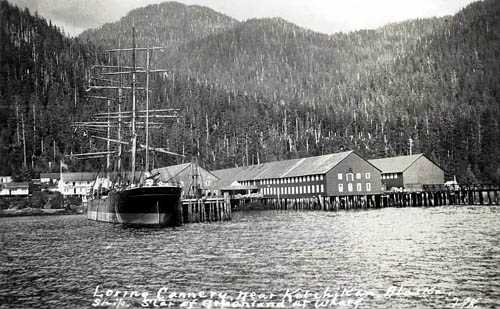 Photographer: Forest J. Hunt Donor: John T. Wynne Courtesy of the Ketchikan Museums, Tongass Historical Society Collection
Loring's days as a cannery town were numbered and its Alaska Packers cannery closed its doors for good in 1930-31. Tom Stack remembered seeing the Chinese men who came to dig up the bones of the Chinese workers who had died and been buried there so they could be sent back to their homeland. The little pioneer graveyard still exists on a hillside above the creek, the final resting place for a few of the sailors from those historic Star ships, and others. The cannery buildings stood abandoned for years but little by little they were dismantled by Ketchikan residents on the north end of town, many of whom admit that their homes were built with lumber salvaged from those old buildings. It is almost impossible to
The Stacks moved to Ketchikan but visited Loring whenever they could - and the grandchildren and their children do the same to this day. When youngest son Tom was 18 he went to work at Sunny Point cannery in Ketchikan. He was working on a seine boat and was at Metlakatla when he met his future wife, Florence. Florence's father had mined at Dawson and then at Fairbanks and Chena and later at the new strikes in Flat and Iditarod. It was at Iditarod that he met and married Florence's mother, who bore him four children but then died suddenly. Florence herself was born aboard the steamer Florence, after which she was named. Her father took Florence and her motherless siblings to Holy Cross Mission to be raised. She was raised by the Sisters of St. Ann until she was old enough to leave. Florence traveled to Tanana with a sister nurse and was trained to work at the hospital in that village. When one of the doctors was transferred to Metlakatla, Florence went along with him as her chaperone. It was there she met Tom. She called him the "quietest man you ever saw!" Tom was indeed a quiet man. But he was also observant and organized. He maintained a journal, a small notebook, of his years in Ketchikan, in which he noted every significant event. Florence and Tom were married in 1940. They lived two years in Ketchikan before moving to Loring. Florence fell in love with it, by now a tiny and almost silent ghost town. But, "it was just wonderful," she once said, "not even a drop of snow, and the river and the sea! Where I came from it was cold!" And she also said, "I never did mind the rain." It was also in 1940 that the family patriarch Richard Stack died. He joined his wife Mariah, who had died five years earlier, at Ketchikan's Bayview Cemetery. Other Stacks are buried there, too. But many remain as residents of Ketchikan, and elsewhere. So if you know a Stack or meet one, you'll know a little bit about the family's proud history.
Read more about Loring...
june@sitnews.org
All rights reserved. Not to be reprinted in any form without the written permission of June Allen.
|
|||||||||||
